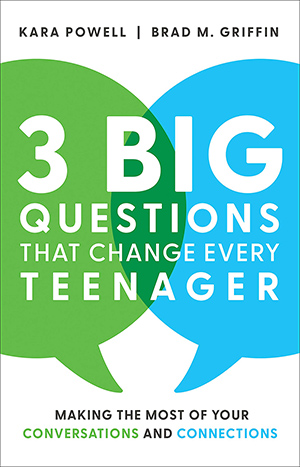Book Review: 3 Big Questions That Change Every Teenager: Making The Most Of Your Conversations And Connections

3 Big Questions That Change Every Teenager: Making The Most Of Your Conversations And Connections by Kara Powell and Brad M. Griffin. Baker Books: Grand Rapids, MI. 2021. Total pages: 294.
Fuller Youth Institute (FYI) provides resources for youth ministry practitioners by turning academic research into practical guides. Kara Powell and Brad Griffin took on the enormous task of dissecting the theory of development while pairing it with teen discipleship research.[i] Tacitly, they modeled the inseparability of both. Remarkably, the research took 2200 surveys, 27 in-depth interviews and a robust literature review, all completed over a two year period.
The prior two main researches of FYI, Sticky Faith and Growing Young, dealt with the faith transition from high school to college as well as how some churches seem to engage this age group better than others. Furthermore, In 3 Big Questions That Change Every Teenager, Kara and Brad provide an unprecedented guide to help adolescents follow Christ through exploring development.
These three big questions come from the psychosocial process called Individuation and its triple tasks: identity, belonging, and purpose. Individuation maps the person’s journey from dependency (childhood) to interdependency (adulthood). Each task corresponds to three fundamental questions: Who am I? Where do I fit? and What difference can I make?
Powell and Griffin propose that the Bible provides the best answers to each of these questions. Furthermore, active listening serves as the best tool adults could use to serve adolescents in this developmental quest. They maintain that “hearing faith stories builds faith language” (79).
Brilliantly, Powell helps the reader to format conversations with teens in a way that God becomes central instead of an annex or a casual mention. Powell also gives clear advice in guiding conversations, informed by best counseling practices and personal experience. Therefore, the scripted questions reflect the purpose of weaving discipleship with development while highly encouraging active listening skills. Adults withhold the offer of their own insight only if necessary, and only at the end. Powell suggests a simple structure: Now-God-How. Now–what is on the student’s mind? God–how is God present in the current situation? How–practical advice moving forward. Such structure is helpful whether the conversation focuses on identity, belonging, or purpose (83). Additionally, at the end of each chapter, the writers provide a space intended for self-reflection as a way to aid future conversations with adolescents.
Insightfully, the authors look at development and discipleship through the eyes of teens. For instance, they framed discipleship in a simple phrase: Saying Yes to Jesus! An action taken every moment, every day, in every decision. They chose biblical phrasing for development: you are enough (Jn 6: 1-15), you belong to God’s people (Jn 13; 14-15), and you are invited into God's greater story (1 Cor 3: 5-9) (217, 254).
When discussing Identity, for instance, Kara and Brad suggested the need to understand the concept of “Being” since it is out of that relationship that “Doing” flows. Adventists might find the suggestion that the Sabbath offers great identity-shaping disciplines, such as: Silence, Rest, Retreat, and Worship surprisingly affirming (128, 129).[ii]
Many youth ministry books have systematically conducted research in the dominant culture while keeping minorities at the margins. In this book, FYI recognizes diversity in the human subjects and also in the research team and literature review (46, 57). Equally laudable, the researchers acknowledge the limitations of this study–a two-hour interview is not enough to infer the discipleship journey of an individual, much less an adolescent. To that end, the research method aligns with the intent of the study of giving a fresh look at discipleship formation.
Powell and Griffin use the word “purpose” instead of “autonomy” as first proposed by Chap Clark, a former Fuller Youth Ministry professor. Clark insisted that the word “purpose” (What difference can I make?) best describes the developmental journey of older youth (What gifts, talents and abilities do I have and how can I turn them into vocation and career?). While early and mid-adolescents seem to struggle with “autonomy” (Do my decisions count? Can I drive to wherever I want, with whoever I please, for as long as I so desire? Can I come home past midnight? Can I skip church this weekend?). Autonomy, therefore, seems to better describe the developmental needs of high school students, while Purpose seems to better fit the quest for meaning of college students. Perhaps this clarification would be helpful for the reader since older high schoolers maybe more focused on Purpose while younger high schoolers may be more concern with Autonomy.[iii]
The topic of social capital as a crucial element in development and discipleship is not emphasized strongly enough in this book, in spite of the assumption of community and its casual mention in the book.[iv] Nonetheless, it is implied in the mentorship nature of this guide–a mentor should also be a “connector,” something stressed in books such as Sticky Faith.[v]
In the Adventist context, one of the best youth ministry tools for development and discipleship formation is Club Ministries. The level of social capital, in addition to skills exploration assignments, make this ministry ideal for discipleship and development formation. Since this book comes from FYI, it doesn’t specify this Adventist application.
3 Big Questions that Change Every Teenager is a must-have book for youth ministry professionals, volunteers, and parents, including those in the Adventist context.
 |
Nelson Silva, DMin, serves as the associate youth director for the Kentucky-Tennessee Conference. |
[i] Although the word “development” never appears in the book, the authors clearly described the concept.
[ii] The authors reference Eugene Peterson’s description of the Sabbath: “pray and play.” Traditionally, Adventist in the Americas and Africa may have an objection with Sabbath as a “day to play.”
[iii] Chap Clark. Youth Ministry University. Understanding The Students You Are Working With. https://www.ymuniversity.com/login. Accessed on May 15, 2021. It is also worth noting that the order of the triple task of adolescents (Identity, autonomy and belonging), as once proposed by Chap Clark, was modified in this research by moving belonging to the second place. Although it is clear that development and discipleship are not a linear processes, it is also noticeable that belonging has taken a dominant role in recent years as far as development and ministry is concerned–Belonging before Believing (44).
[iv] I particularly appreciated the conversation starters on purpose, especially because it includes community. A useful exercise is to visually compare the young person's impressions of her gifts, talents and abilities (written on a board) with the adult’s impressions of her gifts, talents and abilities. Then, the young person can clearly see what she has been called to, while skills and talents are matched with causes, issues or ideas she is passionate about (222).
[v] Fuller Youth Institute. https://fulleryouthinstitute.org/stickyfaith Accessed on May, 15 2021. See Intergenerational relationships–5:1.
